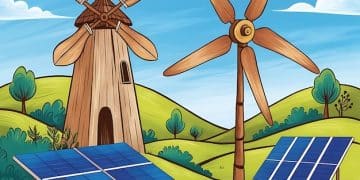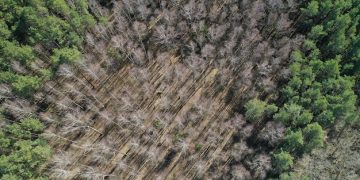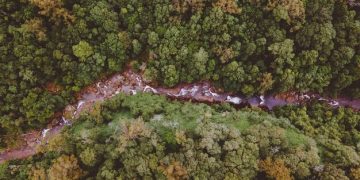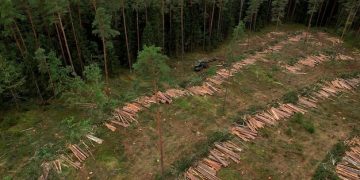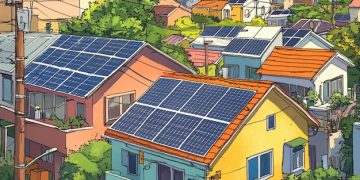Deforestation & Water Cycles: A Crisis for US Agriculture
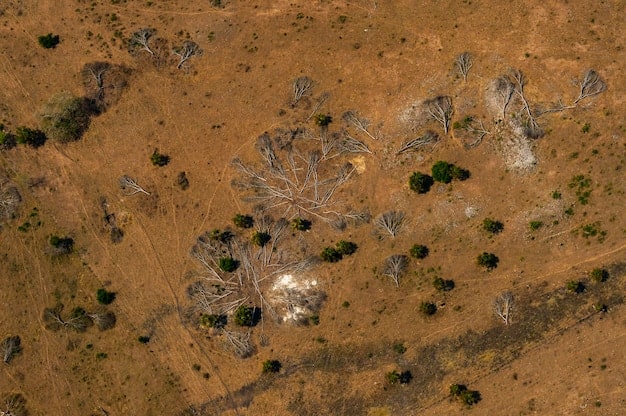
Deforestation and the disruption of water cycles pose a significant threat to US agriculture, leading to decreased rainfall, increased drought risk, and compromised crop yields, impacting the nation’s food security and economic stability.
The intricate relationship between forests and water cycles is becoming increasingly evident, particularly in the context of US agriculture. Deforestation and the disruption of water cycles are not just environmental concerns; they represent a looming crisis for American farms and food production.
Understanding the Interconnection Between Deforestation and Water Cycles
The link between deforestation and water cycles is fundamental to understanding the broader environmental impact. Forests play a crucial role in maintaining regional and global water balance. When forests are cleared, the delicate equilibrium of water cycles is disrupted.
How Forests Influence Water Cycles
Forests act as natural sponges, absorbing rainfall and releasing it slowly into streams and groundwater. This process ensures a steady supply of water throughout the year, even during dry periods.
- Water Absorption: Trees and forest vegetation intercept rainfall, reducing runoff and soil erosion.
- Groundwater Recharge: Forests facilitate the infiltration of water into the ground, replenishing aquifers and maintaining groundwater levels.
- Evapotranspiration: Trees release water vapor into the atmosphere through transpiration, contributing to cloud formation and precipitation.
Deforestation disrupts these processes, leading to increased runoff, reduced groundwater recharge, and decreased rainfall. This can have severe consequences for agriculture, which relies heavily on a stable and predictable water supply.

The Impact of Deforestation on Rainfall Patterns in the US
One of the most significant consequences of deforestation is its effect on rainfall patterns. Forests contribute to local and regional rainfall through evapotranspiration, the process by which water is transferred from the land to the atmosphere by evaporation from the soil and other surfaces and by transpiration from plants.
Studies have shown that deforestation can lead to a decrease in local rainfall. For example, the removal of forests in the Amazon basin has been linked to reduced rainfall in the region, affecting agricultural productivity.
Regional Variations in Rainfall Reduction
The impact of deforestation on rainfall patterns varies across the US. Areas with extensive deforestation, such as the Pacific Northwest and the Southeast, have experienced changes in rainfall patterns that affect agriculture.
- Pacific Northwest: Deforestation has been associated with reduced snowpack, which is crucial for irrigation during the dry summer months.
- Southeast: Conversion of forests to agricultural land has led to altered rainfall patterns, increasing the risk of drought.
- Midwest: Loss of windbreaks and shelterbelts has reduced soil moisture retention, impacting crop yields.
Understanding these regional variations is essential for developing targeted strategies to mitigate the impact of deforestation on agriculture.
Increased Drought Risk and Its Implications for US Agriculture
Deforestation exacerbates drought conditions by reducing the land’s ability to retain water. When forests are removed, the soil becomes more exposed to the sun and wind, leading to increased evaporation and decreased soil moisture. This can have dire consequences for agriculture, particularly in regions already prone to drought.
The consequences of increased drought risk for US agriculture are far-reaching, affecting crop yields, livestock production, and farm incomes. Droughts can lead to crop failures, reduced grazing land, and increased water scarcity.
Strategies for Drought Mitigation in Agricultural Practices
Implementing drought-resistant crops is a key strategy for mitigating the impact of drought on agriculture. These crops are specifically bred to withstand dry conditions and require less water than traditional varieties.
Water conservation techniques, such as drip irrigation and rainwater harvesting, can also help reduce water consumption and improve water use efficiency in agriculture.
Compromised Crop Yields and Food Security Concerns
The disruption of water cycles due to deforestation directly impacts crop yields. Water is essential for plant growth, and when water availability is reduced, crops suffer. This can lead to decreased yields and increased food prices, affecting both farmers and consumers.
Reduced crop yields can also have broader implications for food security, both in the US and globally. As agricultural productivity declines, the ability to meet the growing demand for food is compromised, potentially leading to food shortages and increased reliance on imports.
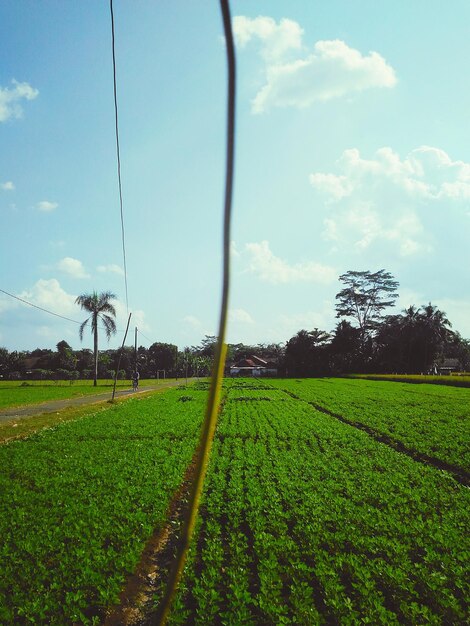
The Role of Sustainable Forest Management in Maintaining Crop Yields
Sustainable forest management practices are crucial for mitigating the impact of deforestation on crop yields. These practices involve managing forests in a way that maintains their ecological functions while still allowing for timber harvesting and other uses.
- Reforestation: Planting trees in deforested areas helps restore water cycles and improve soil health.
- Agroforestry: Integrating trees into agricultural systems can provide shade, reduce soil erosion, and improve water infiltration.
- Selective Logging: Harvesting timber in a way that minimizes disturbance to the forest ecosystem helps maintain its ability to regulate water cycles.
By adopting sustainable forest management practices, we can help ensure that forests continue to provide essential ecosystem services, including water regulation, which is vital for maintaining crop yields and food security.
Economic Losses and the Financial Burden on US Farmers
The economic losses associated with deforestation-related water cycle disruptions place a significant financial burden on US farmers. Decreased crop yields, increased irrigation costs, and livestock losses all contribute to reduced farm incomes.
These economic losses can have cascading effects on rural communities and the broader economy. Farmers may struggle to repay loans, invest in new technologies, or maintain their operations, leading to business failures and job losses.
Government Policies and Financial Assistance for Affected Farmers
Government policies play a crucial role in supporting farmers affected by deforestation-related water cycle disruptions. Financial assistance programs can provide farmers with the resources they need to cope with drought, crop failures, and other challenges.
Incentives for adopting sustainable agricultural practices, such as water conservation and soil health management, can also help reduce the financial burden on farmers and improve the long-term resilience of agricultural systems.
Policy Recommendations for Sustainable Land Management and Conservation
Addressing the issue of deforestation and its impact on water cycles requires a comprehensive approach that includes policy recommendations for sustainable land management and conservation. These policies should focus on protecting existing forests, promoting reforestation, and encouraging sustainable agricultural practices.
In addition, raising awareness among farmers, policymakers, and the public about the importance of forests and water cycles is essential for fostering a greater commitment to conservation and sustainable land management.
Enhancing Collaboration Among Stakeholders for Effective Conservation
Effective conservation requires collaboration among various stakeholders, including government agencies, farmers, researchers, and environmental organizations. By working together, these stakeholders can develop and implement strategies that address the complex challenges of deforestation and water cycle disruption.
- Data Sharing: Sharing data on forest cover, water availability, and agricultural practices can help inform decision-making and improve the effectiveness of conservation efforts.
- Public-Private Partnerships: Encouraging public-private partnerships can leverage resources and expertise to support conservation initiatives.
- Community Involvement: Engaging local communities in conservation efforts can help ensure that policies are tailored to local needs and priorities.
Only through collaborative efforts can we hope to reverse the trends of deforestation and water cycle disruption and secure a sustainable future for US agriculture.
| Key Point | Brief Description |
|---|---|
| 🌳 Deforestation | Leads to reduced rainfall and increased drought risk. |
| 💧 Water Cycles | Disrupted by deforestation, impacting US agriculture. |
| 📉 Crop Yields | Compromised due to water scarcity from deforestation. |
| 💰 Economic Losses | Farmers face financial burdens due to decreased productivity. |
What are the main causes of deforestation in the US?
▼
The main causes of deforestation in the US include logging, agriculture expansion, urbanization, and mining activities.
What are the consequences of deforestation on water cycles?
▼
Deforestation disrupts water cycles by reducing rainfall, increasing runoff, and decreasing groundwater recharge, leading to drought conditions.
How does deforestation impact US agriculture?
▼
Deforestation leads to compromised crop yields, increased irrigation costs, and greater vulnerability to drought, impacting farm incomes.
What strategies can be used to mitigate the impact of deforestation?
▼
